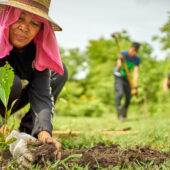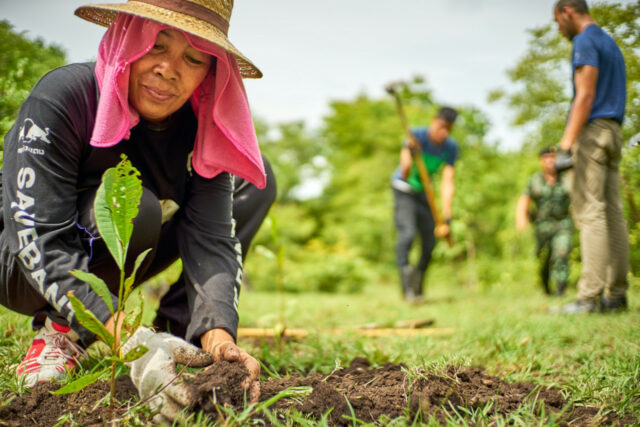After years of negotiations, a deal on the rules governing global trading in carbon offsets was reached at COP26. Barbara Baarsma, CEO of Rabo Carbon Bank, expects a strong surge in demand for high-quality carbon credits.

CV
- CEO Rabo Carbon Bank, March 2021- present
- Chair of the executive board of Rabobank Amsterdam, 2019-March 1, 2021
- Director of knowledge development at Rabobank and responsible for RaboResearch, 2016-19;
- Professor of applied economics at the University of Amsterdam
- Chair of the Bank Council of DNB (Dutch Central Bank)
While attending the UN climate change conference in Glasgow, Scotland, Baarsma noticed the huge representation of large companies at the climate summit.
Many of these came up with firm net-zero targets, and indicated that they will offset their non-avoidable emissions in the coming years by buying credible carbon credits.
This is a much-needed development: it is estimated that voluntary carbon markets need to grow by more than 15-fold by 2030 in order to support the investment required to deliver the 1.5°C pathway.
The UN gathering clarified – after years of wrangling – an unfinished part of the 2015 Paris agreement, which governs how countries may buy and sell offsets. A new Rule Book now provides more clarity on how carbon projects can be traded internationally.
“It’s not perfect yet, but still an important step forward,” Baarsma tells Impact Investor. “And without doubt it will give a boost to the carbon market.” A form of regulation was also introduced earlier this year for the voluntary carbon market where companies can purchase their required credits.
As a regulator, the independent governance body Taskforce Scaling Voluntary Market will contribute to a more transparent trading market.
Better prices, more transparency
Greater demand for carbon credits will drive higher prices. Present prices are still too low, Baarsma admits. “The discipline of the capital market must also apply to this market.”
Low prices are encouraged by the supply of low-quality projects, with little additionality. Like solar panels on roofs. “You don’t need credits for that. They will pay for themselves.”
The demand for high-quality credits – which in addition to reducing emissions also contribute to improved biodiversity and social goals – should be stimulated by shareholders, NGOs and other stakeholders.
“Low-quality offsets, or emissions reductions counted twice, do too little for the planet – and can even hinder the fight against climate change.”
Baarsma also expects a lot from the new EU Sustainable Finance program, which from 2023 onwards will force a large group of companies to become much more transparent on the broad range of ESG goals, not only with regard to their own actions but also their entire supply chain.
Storing CO2 in trees and soil
Baarsma took charge of the Rabo Carbon Bank in March 2021. The initiative existed for some time already, but she was appointed to accelerate and develop it.
The fact that the Dutch cooperative lender put its top economist and experienced executive forward for this position indicates how much potential it sees for a bank where carbon, instead of money, is the main currency.
The Carbon Bank develops projects that store carbon in trees and soil and reduce greenhouse gas emissions in agri-food chains, in cooperation with farmers. The bank then mediates between them and companies that want to reduce or compensate for their emissions.
Rabobank’s strong presence in the food and agri industry makes the major players in these sectors the most obvious potential buyers of the validated CO2 storage capabilities the Carbon Bank is offering.
“We however see credits merely as a means,” Baarsma says. The ultimate goal of Rabo Carbon Bank is to promote more sustainable agriculture.
According to the UN the global food system is responsible for 34% of greenhouse emissions. Carbon credits have the potential to stimulate the transition to more ‘regenerative’ farming, such as soil sequestration and agroforestry.
First product
The first product the Rabo Carbon Bank launched was an agroforestry initiative in African countries. This initiative focuses on tree planting by small-scale farmers.
According to Baarsma thousands of them are already involved in the current pilot phase. They will be enabled to sell carbon credits to large corporations, which seek compensation for their non-avoidable emissions.
At COP26 the protocol that Rabo Carbon Bank drew up for this project was approved by Plan Vivo, a certification body with a focus on community and smallholder land use. “The fact that we now have this certificate is a big step forward,” says Baarsma. The ultimate target group consists of some 15 million smallholders.
In collaboration with partners like Microsoft, Rabo Carbon Bank can use satellite and other data to measure how much the trees have grown on an annual basis. This should rule out fraud, a danger that many critics of carbon trading regularly point out.
Peat meadow areas
A new product was launched just last week, aimed at Dutch farmers. Here the focus is on soil sequestration. The idea behind it is that by helping farmers to farm more sustainably, they will succeed in storing extra CO2 in the soil. It is the first initiative in the Netherlands in which farmers are paid for applying climate-smart measures.
“Adding compost to the soil or stopping ploughing improves the soil and captures more carbon,” explains Baarsma. “In addition farmers can reduce their emissions, for example by using less fossil fuel and fertiliser, or – specifically in peat meadow areas – by raising the water level.”
In this pilot project Rabo Carbon Bank and a partner organisation bear the costs of monitoring. Approximately 90% of the credit price is paid to the farmer, half of which is in advance. The realised climate gains are calculated and traded in the form of carbon credits.
According to Baarsma companies in the agrifood chain are keen to buy these carbon credits. “Rabo Carbon Banks selects corporate clients with an active sustainability agenda. Not the ones that buy carbon credits to take the easy route,” she says.
Due to the shortage of good quality carbon projects, credit prices are expected to rise quickly. “That is already happening. On the European market, it is already 50-60 euros on the ETS. This will also apply to the price of high quality credits like the ones generated in our initiative in the Netherlands.”
Patience is needed
The ones mentioned above are not the only initiatives of the Rabo Carbon Bank. More pilots are currently being conducted, for example in the US (soil sequestration with large soy and corn farmers) and Brazil (agroforestry).
The credits the US project will generate are already sold out. “And those aren’t the cheapest credits, I can guarantee you,” Baarsma says. But there is still a lot to learn. “What works and what doesn’t. How do you measure, how to monitor?”
Moreover, the soil won’t be healthy all at once if you stop ploughing or start crop rotation. While trees need years to grow and store significant amounts of CO2, patience is also needed when it comes to soil sequestration. Patience according to Baarsma is something that the Rabobank has more of compared with other financial institutions.
“We’re a cooperative bank, not governed by shareholders and impatient capital. We want to use that to create a food system change. The direction is clear, our ambitions and the order of magnitude too. We aim for a significant impact on climate change,” she concludes.
Read also
‘High-quality carbon credits can help companies increase their climate ambition’






